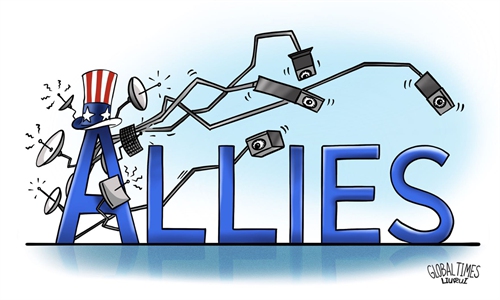US No.1 technology abuser for spying

A huge slogan board stands in front of the US Capitol building during a protest against government surveillance in Washington DC, capital of the United Sates, on Oct 26, 2013. Photo:Xinhua
It's been reported that Namibia recently found in its waters a US saildrone used to gather data underwater. Although Washington claimed that it is a private drone contracted for marine research purposes, Namibian media generally believed it is an American spy drone. According to the latest data released by the South China Sea Strategic Situation Probing Initiative, a think tank, in January this year, 64 sorties of US military land-based reconnaissance aircraft were spotted over the South China Sea.As a matter of fact, the US is the No.1 country in surveillance and reconnaissance. It has long begun its plan to establish intelligence gathering and reconnaissance networks around the world by using emerging technologies. It is trying to build an absolute comparative advantage in information and intelligence competition in the fields of space, air, maritime and networks. In 2005, the US put forward its National Plan to Achieve Maritime Domain Awareness to gradually expand its domain awareness network to various regions around the world.
Since 2010, with the shift of its global strategic focus to the Western Pacific region and the development of unmanned and intelligent technologies, the US has unprecedentedly increased its reconnaissance and monitoring activities in the East China Sea, South China Sea, the Taiwan Straits and waters surrounding China as well as the South Pacific Ocean.
Take the South China Sea for example, the reconnaissance operations of the US military have increasingly shown the following distinctive characteristics: First, the frequency of reconnaissance missions are high. Data released by the South China Sea Strategic Situation Probing Initiative shows that 668 sorties of US reconnaissance aircraft were spotted over the South China Sea in 2022. Second, the US has not only dispatched large reconnaissance aircrafts such as the RC-135, EP-3E, RQ-4, and P-8A, but also deployed oceanographic research vessels, unmanned underwater vehicles, and submarines. Third, the US routinely uses civil aviation aircraft and impersonates other countries' civil aviation codes to carry out intelligence collection. The US military has fraudulently used the civil avionics codes of neighboring countries such as Malaysia and the Philippines to carry out reconnaissance operations against China in the Yellow Sea and the South China Sea. Commercial aircraft such as Lasai Aviation CL-650 and Beechcraft King Air 350ER are also frequently spotted over the South China Sea.
The US military's land, sea, air, and space information intelligence reconnaissance has four purposes. One is to detect the activities of submarines and surface ships. The second is to use RC-135 and EP-3 electronic reconnaissance aircraft to detect communication signals and radar signals, thereby deciphering and obtaining important data such as radar deployment, and laying the foundation for electronic interference during wartime. The third is to utilize the P-8A Poseidon and the RQ-4 Global Hawk equipped with the synthetic-aperture radar and reconnaissance camera to conduct high-definition reconnaissance and surveillance on the islands and reefs of the South China Sea.
The essence of the US military intelligence network covering the world is to maintain its hegemony at the expense of the security of other countries and regional peace and stability. First, the close-range and frequent reconnaissance of the US has undoubtedly increased the frequency of air and sea encounters and the probability of unexpected events. Second, the US military carried out military reconnaissance by fraudulently using the electronic codes of other countries' civil aviation aircraft, leaving a huge security risk for civil aviation. Third, the US global intelligence-gathering network bases its "own security" on the "insecurity of other countries." Whether it is Namibia or the South Pacific island countries, the US uses intelligent and unmanned technologies to establish various intelligence monitoring sites and deploy various reconnaissance equipments in these countries, which undoubtedly violates the sovereignty of these countries and threatens their security.
Technological progress should be used in areas such as agricultural development and ecological protection. The US is a global leader in research and development in the fields of unmanned, intelligent and informatization technologies, but today it regards technological progress as a tool to enhance war capabilities and a bargaining chip to gain power advantages. This not only damages the confidence of the international community in the US, but also consumes the credibility of the US as the world's largest economy.
The author is director of the World Navy Research Center, National Institute for South China Sea Studies. opinion@globaltimes.com.cn



